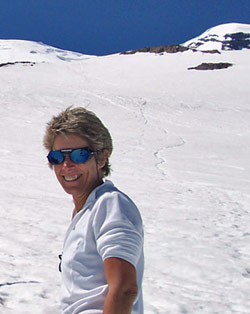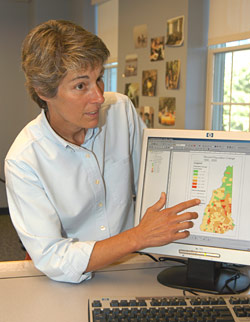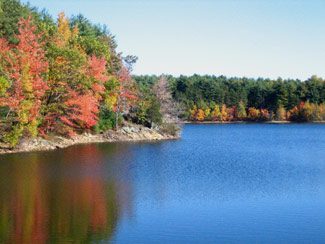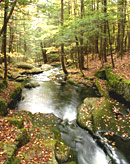Growing Up Near Colby-Sawyer, Professor Laura Alexander's Deep Ties to the Land Define Her In and Out of the Classroom
By Laura Alexander
My sense of place began when my family moved to Newbury in 1967, just before my eighth birthday. Traveling up Rollins Road to our new home site, I learned that the narrow wheel tracks, barely wide enough for my Dad's pickup, were made by horse and buggy. And the horse, Molly, belonged to Willy Rollins, one of the Rollins of Rollins Road. Willy lived in the only house left on that road, and a clause in my parent's deed provided him life tenancy. Our house would sit on the knoll where Willy's horse Molly used to graze.

Willy lived alone, in the shell of his former home with no indoor plumbing or electricity. His right leg was about four inches shorter than his left. He walked bent over, reaching behind his right knee with his right hand to lift that leg and pull it forward. Though his gait was slow, my brother and I couldn't keep up with him during his daily chores.
Willy lived in one room of his house – drying home grown beans upstairs and storing wood in his former bedroom. When we drove past his house, Willy would sit forward in his chair by the window and wave, his gnarled fingers a straight-up salute. Our young family and our television fascinated him. Certainly his self-contained and self-sustaining world fascinated my brother and me.
My younger brother, Colin, and I became intrepid explorers of the world beyond our driveway. Some days we turned left where our driveway met the road, passing the sign warning, “Closed subject to gates and bars.” Swallowed by the forest, this old road provided an exciting path into and through the woods. Near the sign was an old granite slab foundation, filled with moss and growing trees where rooms used to be. We imagined we were the first people to explore this hill, and finding a huge pile of sawdust deep in the woods didn't spoil that vision for us.
We didn't make a connection between that sawdust pile and recent human activity-to us it was a place to dig holes in the summer or, in late fall, to slide down its frozen sides in our sneakers before the deep snow buried it. Further along, beyond an old cemetery, the road came to a “T” and, not knowing which way to go from there, we usually turned around and headed back home. The one time we did go beyond it, my error in judgment meant a long walk home from South Newbury along paved Routes 103 and 103A – all the while my brother chewing me out for getting us lost.
On other days we'd turn right at the end of the driveway and walk along Rollins Road-visiting with Willy, throwing rocks into the brook, and yelling to each other through the culvert on the way to what we called “the sharp corner.” Willy told us that he used to go to school in a building on that corner that was now just forest. Farther along the road we found more cellar holes, lilac bushes, apple trees and a grassy area perfect for resting while staring into the small, tadpole filled, mucky bottomed pond we discovered. Or we might take another spur trail that went off the road to the right climbing relentlessly uphill to a small, rocky clearing where we could see Mt. Sunapee and part of Lake Sunapee-known to others as “Sunset Hill.”
These were the days of my childhood. Each summer day was about choosing left or right at the end of the driveway with only one goal- to return home in time for supper. It never occurred to us to pack a lunch on our daily jaunts because there were always wild berries and tart, wild apples to eat. When we were thirsty we would stick our faces in a brook and drink the clear, cold water.

Is it any wonder that I am deeply attached to our northern hardwood forest-it is “my” woods. I know its smells, sounds, and what it feels like in every season. As a grownup I learned the names of the plants and animals that I already “knew” intimately. To feel whole, I need to spend part of each day outside, checking in with these woods for comfort, joy and balance. It is no wonder I was drawn to a career teaching college students about the environment–committed to helping them cultivate a sense of place like the one that defines who I am.
I moved from my childhood home the fall after I graduated from high school, at the same time that dump trucks started making several trips a day beyond my driveway – to the place where Colin and I turned left to play in the woods. When I returned to visit 10 years later, I heard people describe the beautiful views, now seen from these cleared house sites on the side of the hill that I never saw from within the forest where I played. Nothing was familiar in this new landscape of roads, driveways, and lawns. I felt like a trespasser, in this land that I had freely roamed as a child.
Another 10 years later, as a student in graduate school, I returned to the other “turn” at the end of my childhood driveway– the woods located off the sharp corner. I hadn't been to this forest for about twenty years and I longed to revisit it with the perspective of an environmental studies student–I especially wanted to see if the area around the pond was still a grassy knoll or had reverted to forest.
My former pond was a dry depression in the ground and there was evidence all around that the beavers had moved downstream. The stumps were theirs and, the standing dead snags were the trees they drowned –evidence that this area was flooded for years before they ate themselves, out of house and home. I had plenty of material for my “Plant Communities” paper, but I was also overwhelmed by a sense that I had returned home. Though this forest had changed naturally-it was still “my” forest. How grateful I felt that I could wander here freely once again because this land remained undeveloped - protected by the Society for the Protection of New Hampshire Forests since 1960.

You see, I grew up roaming what is known as the Hay Reservation. Land ownership had no meaning to me as a child. And certainly I had no idea that the two forests at the end of my childhood driveway would change so drastically due to something I now understand as public access. I am truly thankful to the Hay family for having the foresight to conserve their land so it would remain unchanged except by natural forces.
My doctoral dissertation, started nearly 30 years after leaving “my” woods on the southeast side of Lake Sunapee, is informed by my deep attachment to the land. No doubt this led me to explore how others are connected to place, and specifically to learn the meaning of the land for long-term Coos County residents in northern New Hampshire. I suspect I chose this region because its forests and people speak to me about my childhood.
It is a place that remains sparsely populated and undeveloped. People like Willy Rollins still inhabit the Great North Woods. But they are in the midst of a significant change to their economic base, and I wanted to explore if this change would affect how they interacted with the land and if that would affect their well-being. My dissertation research revealed five themes of meaning that the land holds for these people. The land provides stability; it is restorative; it is where people experience spirituality; it provides sustenance; and it fosters development and expression of ecological identity. These themes resonate with me, as well as others I've talked to, and further study may reveal that they are widely-held meanings.
An important finding in my research was that the key to maintaining attachment to lands is access. A question I explored with research participants was, “What, if anything, could diminish your attachment for a place once it was formed?” The answer, overwhelmingly, was development. This is not to say that land should not be developed – on the contrary, I believe it is possible to thoughtfully plan land use in a way that balances human housing needs, healthy working forests, ecological habitat, drinking water resources, working farms, and scenic resources.
It is important to recognize, however, that protecting properties in perpetuity and allowing access to land provides something equally as important in our lives–the psychological well-being realized through our attachment to the land.
Laura Alexander is assistant professor of Environmental Studies at Colby-Sawyer College. Her recently completed doctoral dissertation titled “Meaning of place: exploring long-term residents' attachment to the physical environment in northern New Hampshire” can be accessed here.
Professor Alexander will be the featured speaker at the Science Seminar Wednesday, Feb. 11 at 4 p.m. in Ivey Science Center Room 201. She will discuss "Meaning of Place: Exploring Long-Term Residents' Attachment to the Physical Environment in Northern New Hampshire."
This article was first published in the Ausbon Sargent Land Preservation Trust's Winter 2009 newsletter Chatter, and is re-published here with the organization's permission. Professor Alexander is active in the ASLPT as a trustee, member of the Lands Committee, chair of the Outreach Committee and an easement monitor.



